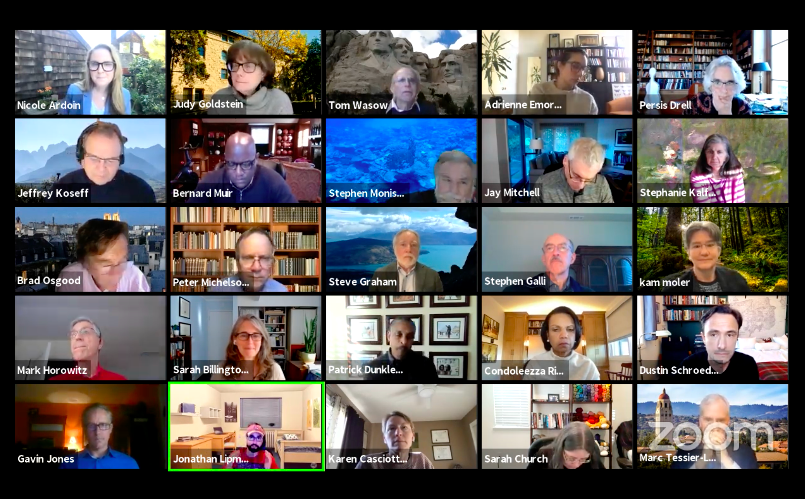University administrators leading planning efforts for the new school focused on climate and sustainability outlined the school’s interdisciplinary structure — which they say will fuse traditional departments and policy institutes — to the Faculty Senate at its Thursday evening meeting. The athletic director also reiterated that serious budget shortfalls had forced Stanford to discontinue 11 varsity sports and offered his tentative support to national efforts to give college athletes more control over their likeness.
“We support reform that provides student-athletes greater flexibility with respect to their name, image and likeness (NIL), but we do worry about how NIL reform might alter the competitive playing field nationally,” said Director of Athletics Bernard Muir.
The new sustainability school, announced by Stanford President Marc Tessier-Lavigne in May, is a product of the Long-Range Vision and seeks to concentrate Stanford scholarship on pressing issues facing the planet. The Blueprint Advisory Committee, charged with developing plans for the new school, found through polls administered in January that most faculty support incorporating the existing Precourt Institute for Energy and the Woods Institute for the Environment into the new school’s organizational structure.
They also agreed that Stanford should emerge from the transition with seven schools: Humanities & Sciences, Law, Business, Engineering, Medicine and Education, along with the new sustainability school. It is not clear if the School of Earth, Energy and Environmental Sciences will be combined with the new school, or if its departments will join different schools.
The committee’s preliminary recommendations reflect faculty support for sustainability research and education that blends the resources of a school and policy institute. Vice Provost and Dean of Research Kathryn Moler told faculty members that the sustainability school will be composed of interdisciplinary departments, a themed-initiatives program and a sustainability “accelerator” anchored in policy and technology.
The new school will offer two new undergraduate sustainability degrees: a sustainability management degree, jointly administered with the Graduate School of Business, and a sustainable development degree, in addition to “enhanced interdisciplinary and disciplinary degrees.”
When asked whether the University would make learning in the sustainability school a requirement, Moler said that there is a “downside to having too many requirements” and that she hopes the course selections will be inviting to all students.
Vice Provost for Undergraduate Education Sarah Church said she was “incredibly excited about the opportunities to incorporate the ideas and the courses and the educational experiences” from the new school into the new first-year Civic, Liberal, and Global Education requirement.
Management science and engineering professor Ramesh Johari questioned how the committee will evaluate if “the incremental impact of moving the resources to the school was overall a net positive,” given resource constraints Stanford is facing due to the pandemic.
Tessier-Lavigne said that since he began his tenure as Stanford’s president, donors and supporters have frequently asked him whether the University would engage in significant efforts toward addressing sustainability and climate.
“There are individuals who are prepared to come and help if we are willing to do something bold and the resources they would make available would not be available under other circumstances,” he said. Although he added that he did not believe this alone was sufficient justification for establishing the new school, he made clear that if the faculty supports its creation, then “there are a lot of resources that will be available from our supporters to enable us to be successful in this sphere.”
The Blueprint Advisory Committee leaders said they would finalize recommendations to the president and provost and make decisions on the name of the school, the intellectual focus of departments and faculty hiring criteria by this summer.
Financial challenges impacting athletics
Muir also briefed the Senate on the challenges facing Stanford Athletics in light of the pandemic, which he said has exacerbated significant flaws in the economic model of college sports nationwide.
Muir said the “extremely painful” decision to discontinue 11 out of 36 varsity sports at the end of the academic year was “driven by our inability to be financially self-sustaining while simultaneously striving to be excellent.”
The University’s decision sparked backlash from canceled sports’ student-athletes and alumni, who are engaging in fundraising efforts to retain varsity status. Stanford, though, has maintained that the decision is final.
Even before the onset of the pandemic, the athletics department had profitability concerns, recording its first structural deficit in fiscal year 2019. At the time, that deficit was projected to reach 18 million dollars by fiscal year 2024. The pandemic added insult to injury.
The decision to cut sports, according to Muir, reduces the projected deficit by half. Philanthropy accounts for 40% of the department’s revenue, and Pac-12 television deals account for approximately 25%, while the rest comes from ticketing and corporate sponsorships.
Muir also expressed qualified support for national efforts to allow college athletes to monetize their likeness. Congress is likely to pass legislation barring the NCAA or other college sports associations from restricting its players’ endorsement deals by late summer, said Ryan Adesnik, Stanford’s vice president for government affairs.
Sen. Cory Booker ’91, a former Stanford football player, introduced a proposal in December, called the College Athletes Bill of Rights, that would give some college athletes a share of their sport’s lucrative profits, in addition to establishing government oversight of health and safety standards and providing lifetime scholarships. Booker’s bill is the latest in a series of legislative efforts to advocate for student-athletes.
